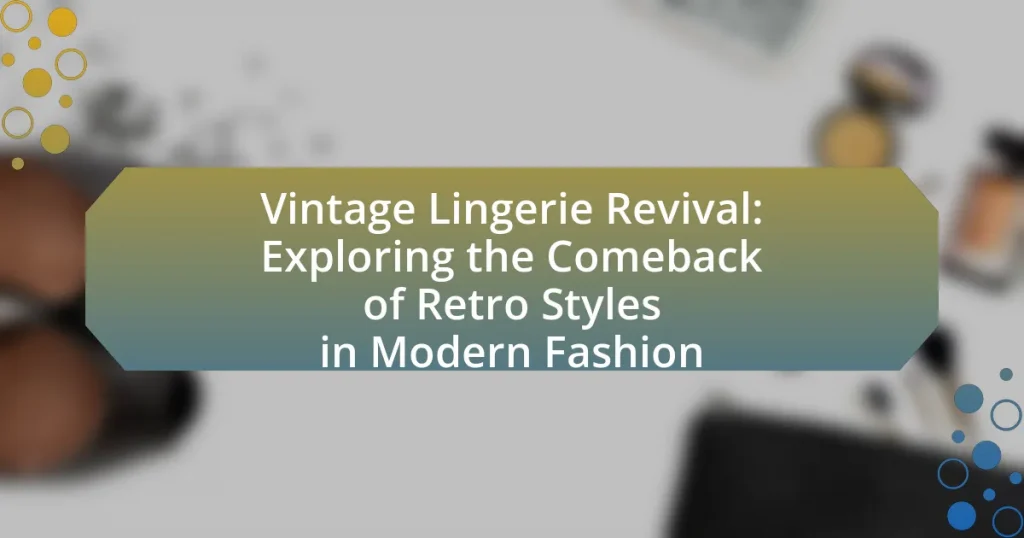The Vintage Lingerie Revival highlights the renewed interest in lingerie styles from the 1920s to the 1980s, characterized by retro aesthetics, unique designs, and high-quality craftsmanship. This trend has emerged from a growing appreciation for nostalgia in fashion, influenced by social media and a desire for individuality. The article explores the historical origins of vintage lingerie, societal changes that shaped its evolution, and the key characteristics that distinguish it from contemporary styles. Additionally, it examines how modern consumers perceive vintage lingerie, the role of fashion designers in the revival, and practical tips for incorporating these pieces into everyday wardrobes. Challenges in the vintage lingerie market, including authenticity and sizing discrepancies, are also addressed, providing a comprehensive overview of this fashion phenomenon.

What is the Vintage Lingerie Revival?
The Vintage Lingerie Revival refers to the resurgence of interest in lingerie styles from past decades, particularly those from the 1920s to the 1980s. This revival is characterized by a focus on retro aesthetics, including the use of vintage fabrics, designs, and silhouettes that emphasize femininity and craftsmanship. The trend has gained traction due to a growing appreciation for nostalgia in fashion, as well as a desire for unique, high-quality pieces that stand out in contemporary wardrobes. The popularity of vintage lingerie has been supported by social media platforms, where influencers and brands showcase these styles, further driving consumer interest and demand.
How did vintage lingerie styles originate?
Vintage lingerie styles originated in the early 20th century as a response to changing social norms and advancements in textile technology. The introduction of lighter fabrics and the shift towards more form-fitting clothing led to the creation of garments like camisoles, corsets, and slips, which emphasized femininity and elegance. By the 1920s, the flapper movement further influenced lingerie design, promoting a more liberated silhouette that favored comfort and practicality over restrictive styles. This evolution was marked by the use of lace, silk, and intricate detailing, reflecting the fashion trends of the time and the desire for both beauty and functionality in women’s undergarments.
What historical influences shaped vintage lingerie designs?
Historical influences that shaped vintage lingerie designs include the Victorian era’s emphasis on modesty, the flapper movement’s liberation in the 1920s, and the post-World War II celebration of femininity. The Victorian period introduced corsets that defined the hourglass figure, while the 1920s flapper style favored more relaxed silhouettes, leading to the creation of bras and slips that prioritized comfort. After World War II, lingerie became more decorative and sensual, reflecting societal changes and the rise of Hollywood glamour. These historical contexts significantly influenced the aesthetics and functionality of vintage lingerie, making it a reflection of the evolving roles and perceptions of women throughout history.
How did societal changes impact lingerie fashion in the past?
Societal changes significantly influenced lingerie fashion by shifting perceptions of femininity, modesty, and body image. For instance, the women’s liberation movement in the 1960s and 1970s led to a rejection of restrictive garments, resulting in the popularity of more comfortable and practical lingerie styles, such as bralettes and boyshorts. Additionally, the rise of body positivity in the late 20th century encouraged diverse representations of women’s bodies, prompting lingerie brands to expand their size ranges and promote inclusivity. Historical events, such as World War II, also impacted lingerie design, as women entered the workforce and sought functional yet stylish undergarments, leading to innovations like the padded bra and the use of synthetic materials.
Why is there a resurgence of vintage lingerie in modern fashion?
The resurgence of vintage lingerie in modern fashion is driven by a growing appreciation for nostalgia and individuality. Consumers increasingly seek unique pieces that reflect personal style, and vintage lingerie offers distinct designs that stand out from mass-produced options. Additionally, the rise of body positivity movements has encouraged the celebration of diverse body types, making vintage styles, often characterized by their intricate craftsmanship and flattering silhouettes, more appealing. Historical context shows that vintage lingerie, particularly from the 1920s to the 1970s, featured innovative materials and designs that resonate with contemporary aesthetics, further fueling this revival.
What cultural factors are driving the revival of retro styles?
The revival of retro styles is primarily driven by nostalgia, cultural shifts towards individuality, and the influence of social media. Nostalgia for past decades, particularly the 70s, 80s, and 90s, creates a longing for the aesthetics and values of those times, which are often perceived as simpler and more authentic. Additionally, the current cultural emphasis on self-expression encourages individuals to embrace unique and vintage styles as a form of personal identity. Social media platforms, especially Instagram and TikTok, amplify this trend by showcasing vintage fashion, allowing users to share and discover retro styles, thus creating a community around these aesthetics. This combination of nostalgia, individuality, and social media influence solidifies the cultural factors driving the revival of retro styles.
How do modern consumers perceive vintage lingerie?
Modern consumers perceive vintage lingerie as a blend of nostalgia and fashion statement, appreciating its unique designs and craftsmanship. This perception is driven by a growing trend towards sustainable fashion, where vintage items are valued for their quality and individuality. According to a 2021 survey by ThredUp, 70% of consumers expressed interest in purchasing second-hand clothing, including vintage lingerie, highlighting a shift towards valuing pre-owned items for their character and history. Additionally, social media platforms like Instagram and TikTok have amplified the visibility of vintage lingerie, with influencers showcasing its aesthetic appeal, further solidifying its status as a desirable fashion choice among contemporary shoppers.
What are the key characteristics of vintage lingerie styles?
Vintage lingerie styles are characterized by intricate lace, delicate fabrics, and a focus on femininity and elegance. These styles often feature high-waisted panties, corsets, and garter belts, which emphasize the hourglass figure. Additionally, vintage lingerie typically incorporates soft pastel colors, floral patterns, and embellishments like bows and ruffles, reflecting the fashion trends of the early to mid-20th century. The use of materials such as silk, satin, and chiffon further enhances the luxurious feel associated with vintage lingerie, making it distinct from contemporary designs.
What materials and designs are commonly associated with vintage lingerie?
Vintage lingerie is commonly associated with materials such as silk, lace, satin, and cotton, along with designs that feature intricate detailing, high-waisted silhouettes, and delicate embellishments. Historically, silk and lace were favored for their luxurious feel and aesthetic appeal, while satin provided a smooth finish that was popular in the mid-20th century. High-waisted panties and garter belts were prevalent designs, reflecting the fashion trends of the 1920s to the 1950s, which emphasized femininity and elegance. The use of these materials and designs not only highlights the craftsmanship of the era but also influences contemporary fashion, as modern brands often draw inspiration from these vintage styles to create nostalgic yet modern pieces.
How do vintage styles differ from contemporary lingerie trends?
Vintage styles differ from contemporary lingerie trends primarily in design aesthetics and functionality. Vintage lingerie, often characterized by intricate lace, corsetry, and high-waisted silhouettes, emphasizes a romantic and nostalgic appeal, reflecting styles from the early to mid-20th century. In contrast, contemporary lingerie trends focus on comfort, minimalism, and inclusivity, often featuring seamless designs, diverse sizing, and practical materials like microfiber. Historical context supports this distinction, as the 1920s to 1950s lingerie was designed to shape the body into specific silhouettes, while modern lingerie prioritizes body positivity and everyday wearability, aligning with current societal values.

How is Vintage Lingerie Being Integrated into Modern Fashion?
Vintage lingerie is being integrated into modern fashion through the incorporation of retro styles into contemporary clothing designs. Designers are blending vintage silhouettes, such as high-waisted panties and bralettes, with modern fabrics and cuts, creating a fusion that appeals to current fashion trends. This integration is evident in collections from brands like Savage X Fenty and Victoria’s Secret, which have introduced vintage-inspired pieces that emphasize both comfort and aesthetics. Additionally, the rise of social media platforms has facilitated the resurgence of vintage lingerie as influencers showcase these styles, further popularizing their use in everyday outfits.
What role do fashion designers play in the vintage lingerie revival?
Fashion designers play a crucial role in the vintage lingerie revival by reinterpreting and modernizing classic styles for contemporary consumers. They draw inspiration from historical designs, incorporating elements such as lace, silk, and intricate detailing that characterized vintage lingerie, while also adapting these pieces to fit modern aesthetics and body types. This revival is evidenced by the increasing presence of vintage-inspired collections in major fashion shows and retail outlets, where designers like Dita Von Teese and Vivienne Westwood have successfully integrated retro lingerie into their lines, appealing to a growing market that values nostalgia and craftsmanship.
Which designers are leading the charge in retro lingerie styles?
Designers leading the charge in retro lingerie styles include Dita Von Teese, known for her vintage-inspired pieces that emphasize classic silhouettes, and Agent Provocateur, which often incorporates retro aesthetics into its collections. Additionally, brands like Playful Promises and Boudoir by Kiki have gained recognition for their playful takes on vintage lingerie, blending modern elements with nostalgic designs. These designers are pivotal in the resurgence of retro lingerie, as evidenced by their consistent presence in fashion shows and collaborations that celebrate vintage styles.
How are fashion shows showcasing vintage lingerie trends?
Fashion shows are showcasing vintage lingerie trends by incorporating retro designs, fabrics, and silhouettes that evoke nostalgia while appealing to contemporary aesthetics. Designers are reviving styles from the 1920s to the 1990s, featuring elements such as lace, satin, and intricate detailing that were popular in those eras. For instance, the use of high-waisted panties and bralettes reminiscent of the 1950s has been prominent on runways, reflecting a blend of comfort and vintage charm. This revival is supported by consumer interest in sustainable fashion and the desire for unique, timeless pieces, as evidenced by increased sales in vintage-inspired lingerie collections.
How are consumers incorporating vintage lingerie into their wardrobes?
Consumers are incorporating vintage lingerie into their wardrobes by using it as statement pieces layered under contemporary clothing. This trend reflects a growing appreciation for nostalgia and unique fashion, with many individuals opting for vintage bras, corsets, and slips to add a touch of elegance and individuality to their outfits. According to a 2022 survey by the Fashion Institute of Technology, 65% of consumers reported that they enjoy mixing vintage items with modern pieces, highlighting the popularity of this style fusion.
What styling tips can help integrate vintage lingerie into everyday outfits?
Integrating vintage lingerie into everyday outfits can be achieved by layering it under sheer tops or blouses, which allows the intricate details to subtly show through. This approach not only highlights the vintage aesthetic but also maintains a modern look. Additionally, pairing vintage bralettes with high-waisted jeans or skirts creates a balanced silhouette that is both stylish and comfortable. Accessories such as oversized blazers or cardigans can further enhance the outfit while providing coverage. The use of vintage lingerie as outerwear, such as incorporating a lace camisole with tailored trousers, showcases the versatility of these pieces. This method aligns with current fashion trends that embrace mixing delicate fabrics with structured garments, making vintage lingerie a chic addition to daily wear.
How do vintage lingerie pieces enhance modern fashion statements?
Vintage lingerie pieces enhance modern fashion statements by adding a layer of sophistication and nostalgia to contemporary outfits. These pieces often feature intricate lace, unique cuts, and vintage-inspired designs that contrast with modern minimalist styles, creating a visually striking combination. For instance, incorporating a vintage lace bralette under a tailored blazer can elevate the overall look, merging elegance with modernity. Additionally, the resurgence of vintage lingerie in fashion trends is supported by designers like Gucci and Dior, who have integrated retro elements into their collections, demonstrating the enduring appeal and versatility of these pieces in today’s fashion landscape.

What Challenges and Considerations Exist in the Vintage Lingerie Market?
The vintage lingerie market faces several challenges and considerations, including authenticity, sizing discrepancies, and market demand. Authenticity is crucial, as consumers seek genuine vintage pieces, which requires sellers to verify the age and origin of items. Sizing discrepancies pose a challenge since vintage sizing often differs significantly from modern standards, leading to potential fit issues for buyers. Additionally, fluctuating market demand can impact pricing and availability, as trends in vintage fashion can be unpredictable. These factors collectively influence the viability and success of businesses operating within the vintage lingerie sector.
What are the common misconceptions about vintage lingerie?
Common misconceptions about vintage lingerie include the belief that it is uncomfortable, impractical, or solely designed for the male gaze. In reality, many vintage lingerie pieces were crafted with a focus on both aesthetics and comfort, utilizing materials like silk and lace that feel luxurious against the skin. Additionally, vintage lingerie often features functional designs, such as supportive bras and shapewear that enhance the wearer’s natural silhouette. Historical context shows that lingerie styles evolved to empower women, reflecting their changing roles in society rather than merely catering to male preferences.
How does sizing differ between vintage and modern lingerie?
Sizing in vintage lingerie typically runs smaller than modern lingerie, reflecting historical body standards and manufacturing practices. For instance, a vintage size 34B may correspond to a modern size 32C, indicating a shift in sizing standards over the decades. This discrepancy arises from changes in body shape ideals and the introduction of more standardized sizing systems in contemporary fashion, which often accommodate a wider range of body types. Additionally, vintage lingerie often features less stretch and more structured designs, further influencing fit compared to the more elastic and forgiving materials used in modern lingerie.
What should consumers know about the care and maintenance of vintage pieces?
Consumers should know that vintage pieces require specific care and maintenance to preserve their quality and longevity. Proper cleaning methods, such as hand washing in cold water with mild detergent, are essential to prevent damage to delicate fabrics. Additionally, consumers should avoid harsh chemicals and high heat when drying, as these can degrade materials. Storing vintage items in a cool, dry place away from direct sunlight helps prevent fading and deterioration. Regular inspections for signs of wear, such as fraying or discoloration, allow for timely repairs, ensuring that these unique pieces remain in good condition.
How can consumers find authentic vintage lingerie?
Consumers can find authentic vintage lingerie by exploring specialized vintage shops, online marketplaces, and auctions that focus on retro fashion. Many vintage boutiques curate collections that include genuine pieces from past decades, ensuring authenticity through expert sourcing. Online platforms like Etsy and eBay feature sellers who specialize in vintage items, often providing detailed descriptions and provenance for their products. Additionally, attending vintage fairs and estate sales can yield unique finds, as these events often showcase authentic pieces directly from collectors. The vintage lingerie market has seen a resurgence, with a growing number of resources available for consumers seeking genuine items, reflecting the increasing interest in retro styles in modern fashion.
What are the best sources for purchasing vintage lingerie?
The best sources for purchasing vintage lingerie include specialized vintage shops, online marketplaces, and auction sites. Specialized vintage shops often curate collections that focus on authentic pieces from specific eras, ensuring quality and authenticity. Online marketplaces like Etsy and eBay provide a wide range of options from various sellers, allowing buyers to find unique items. Auction sites such as Bonhams and Sotheby’s occasionally feature vintage lingerie in their fashion auctions, offering rare and collectible pieces. These sources are recognized for their reliability and extensive selections, making them ideal for vintage lingerie enthusiasts.
How can buyers ensure the quality and authenticity of vintage items?
Buyers can ensure the quality and authenticity of vintage items by thoroughly researching the item’s history, examining labels and tags, and seeking expert opinions. Researching the item’s provenance helps buyers understand its background and value, while examining labels can reveal production details that indicate authenticity, such as brand names and manufacturing dates. Additionally, consulting with vintage fashion experts or appraisers can provide insights into the item’s legitimacy and condition, as they can identify specific characteristics that distinguish genuine vintage pieces from reproductions.
What are some practical tips for embracing the vintage lingerie revival?
To embrace the vintage lingerie revival, start by selecting pieces that reflect authentic vintage styles, such as high-waisted panties, lace-trimmed bras, and silk camisoles. These items often feature intricate details and classic silhouettes that evoke the charm of past decades. Additionally, consider shopping at vintage boutiques or online platforms specializing in retro lingerie, as they provide curated selections that ensure quality and authenticity. Incorporating vintage-inspired accessories, like garter belts and silk robes, can enhance the overall aesthetic. Finally, understanding the historical context of vintage lingerie, such as the influence of the 1920s flapper era or the 1950s pin-up culture, can deepen appreciation and inform styling choices.
How can one start building a vintage lingerie collection?
To start building a vintage lingerie collection, one should first research the specific eras and styles that appeal to them, such as the 1920s flapper styles or the 1950s pin-up looks. Understanding the characteristics of these styles, including fabrics, cuts, and embellishments, is essential for making informed purchases. Collectors can then explore various sources such as vintage shops, online marketplaces like Etsy or eBay, and estate sales, where authentic pieces from these eras can often be found. Additionally, joining vintage lingerie enthusiast groups or forums can provide valuable insights and recommendations on where to find quality items. Collecting vintage lingerie not only requires an eye for detail but also a commitment to preserving the history and craftsmanship of these garments.
What are the best practices for styling vintage lingerie for various occasions?
The best practices for styling vintage lingerie for various occasions include selecting appropriate pieces, layering effectively, and accessorizing thoughtfully. For casual outings, pairing a vintage bralette with high-waisted jeans creates a chic look while maintaining comfort. For formal events, wearing a vintage slip dress as outerwear can evoke elegance, especially when complemented with a tailored blazer. When styling for intimate settings, opting for delicate lace or satin pieces enhances allure, and incorporating vintage-inspired robes can add sophistication. These practices are supported by the resurgence of vintage lingerie in contemporary fashion, as seen in collections by designers like Dita Von Teese, who emphasizes the blend of vintage aesthetics with modern sensibilities.















